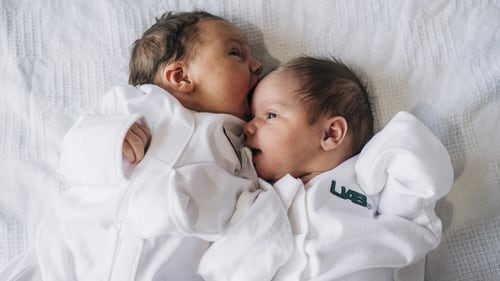By Cody D. Short
Kelsey Hatcher, the mother with a double uterus, delivered her newborn babies, Roxi and Rebel, at UAB Hospital on December 19th and 20th.
The original plan was for Hatcher to naturally go into labor, but at 39 weeks pregnant, she was induced.
When Hatcher arrived at UAB’s Women and Infant Center, she was already dilated 4 cm in her right cervix and 3 cm in her left cervix.
“As my contractions began, they were not consistently together but were within a few seconds of each other,” Hatcher said.
“I felt each side contracting in different areas as well. I felt one consistent with the monitor that started on the left side and moved to the right.”
This is Hatcher’s fourth pregnancy, and in her previous pregnancies, she delivered two babies from her right uterus, and that’s the one that was progressing faster than the left uterus.
The medical team decided to focus on Baby A in the right uterus.
Hatcher delivered Baby A vaginally on December 19th at 7:45 p.m., weighing seven pounds and seven ounces.
Baby B arrived via a C-section 10 hours later on December 20th at 6:10 a.m., weighing seven pounds and 3.5 ounces.
This came to a combined 20 hours of labor.
Hatcher’s obstetrician, Dr. Shweta Patel, was prepared for this to potentially happen.
Patel worked with another obstetrician, Dr. Richard Davis, to come up with three pre-birthing plans: Both babies delivered vaginally; one baby delivered vaginally and the other delivered via c-section; or both babies delivered via c-section.
“While c-sections may be a more controlled delivery option for high-risk cases like this one, we did not want to jump to the third plan immediately, knowing Kelsey’s history of successful vaginal births from both uteri,” Patel said.
“We also listened to Kelsey’s wishes. She wanted to aim to have the same birth experience for the girls as her other children, if safe and possible.”
Since the babies were developed in each uterus, it raised the question of if the babies are actual twins.
Typically, a twin pregnancy is when two eggs are fertilized in one uterus. Patel hypothesized that Hatcher had two eggs released that were fertilized during the same ovulation cycle.
“I think it is safe to call the girls fraternal twins,” Davis said. “At the end of the day, it was two babies in one belly at the same time. They just had different apartments.”
In November, Hatcher told AL.com that she has a rare condition called uterine didelphys, or double uterus.
About three in 1,000 women have a double uterus and two cervixes, according to Patel.
Having a child in each uterus at the same time is extremely rare. Patel said it is a one in a million chance. Hatcher discovered the condition at age 17. She said that because she was a teenager, she was not especially concerned about raising a family at the time.
Hatcher also said, she and her husband, Caleb Hatcher weren’t planning to have a fourth child, let a lone a fifth one.
They had previously gotten rid of all of their baby items, and have now started a GoFundMe, to raise funds for the expenses of two more babies being added to the family. The Hatchers now have five kids, ages 7 and younger.
“Never in our wildest dreams could we have planned a pregnancy and birth like this; but bringing our two healthy baby girls into this world safely was always the goal, and UAB helped us accomplish that,” Hatcher said.
“It seems appropriate that they had two birthdays, though. They both had their own ‘houses,’ and now both have their own unique birth stories.”










